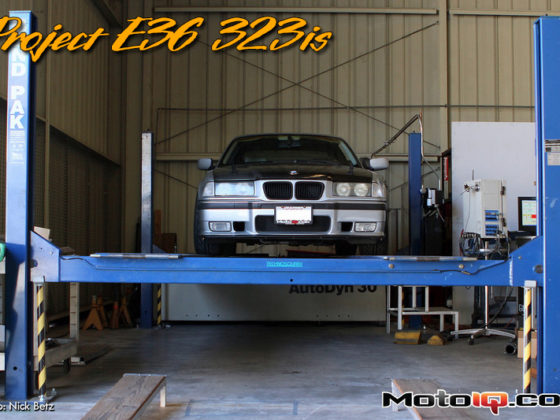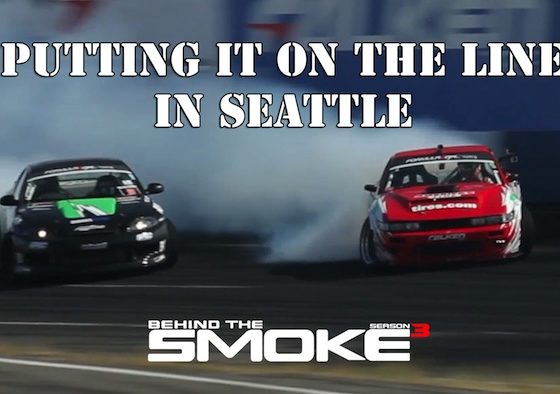
Project Garage X: Taking it to the Track!
A decade ago (which would have made me 13 at the time…), I was “crew chief” for Team Nissan in a little known but televised race, the Honda Nissan Challenge. We spent weeks comparing setup notes, prepping cars for the track, and dusting off some shelves at then Nissan Performance Mag's offices (now MotoIQ.com) for the winning trophies and prizes; then we lost. It was closer than “objects in mirror” and contrary to the trash talking they posed us doing for cameras, we had a blast. But the most amazing thing was how much we broke throughout the day and yet still managed to compete. From fried ECU's to busted clutches, lost wastegate piping to leaking tires, our track “shop” somehow kept up. And kept us in the race.
So when headed to a track day, it makes perfect sense to bring a piece of your garage with you. Let's start with the basics. Whether you are racing or spectating, there are a few essentials that will help you enjoy the day. For whatever reason, most tracks are located in areas of extreme weather conditions. From the hot, arid deserts of Buttonwillow and Chuckwalla to the foggy, rainy mountains of Watkins Glen and Pocono, track days usually fall into two categories: swass-generating or soaking wet. Umbrella or EZ-ups provide shade and shelter. Sunscreen will keep you from looking like a lobster and a rain jacket will keep you dry. A few other keys to happiness- water and ice, snacks, money, and aspirin!
 |
My “flat black Stig” helmet, driving gloves, and driving shoes- high or low top. |
Most tracks have a dress code. It’s not a suit and tie affair but check with the track to know if long sleeves and/or pants are required and if they say they aren't, bring them anyways! Closed toed shoes are not just required but smart. Find some undies that don’t creep up your crack when you're changing tires. A hat and sunglasses can round out your outfit. Don’t forget your helmet and make sure it’s both certified for auto racing and within the year the track is willing to accept. If this isn’t your first rodeo, driver’s suit and gloves and track shoes may complete your threads.
 |
Flip flops and heel/toe technique are a skill that takes quite some time to master and not on the track! But it feels amazing to let your feet breathe during lunch or other groups’ sessions. |
Get your car in good working order ahead of track day. Every car will be subjected to a tech inspection before it’s allowed on the track so if it looks like your car was maintained by sloppy mechanics, you may be sidelined trying to get it in good working order. Unless you want a Big Mac box or last month's issue of (do any paper car mags still exist?) smacking you upside the head when you have to brake check going into a corner, clean out the car. Check all fluids, change the oil, do an alignment, and make sure the battery is fully secured. Don't wait until the day before- you need your sleep!
Bottom line- we don't all have fully enclosed trailers. Most of us drive our cars to track days so there's not enough room to transport an entire garage worth of tools as well. A well-equipped set of tools will repair any simple job that could sideline your fun. A good Plan B is to make friends with those who have trailers or get an AAA Plus membership.
 |
A basic set of tools should include torque wrench and breaker bar, various drives of sockets and wrenches, especially the most used sizes (often 10mm, 12mm, 14mm, 17mm, lug nuts, and axle nut), a few extensions, a BFH, pry bar, and mechanics gloves. These Mechanix Wear MP2's on the right have padded impact zones and 2 ply synthetic leather for heavy jobs; they've saved my hands from being smashed or cut when tranny wrangling or engine dropping. The Craftsman gloves offer more protection than latex but are thin enough to still hand tighten bolts. Throw in a heavy duty impact wrench (with fully charged battery) and an Factory Service Manual and you should have no issues completing most jobs. |
If you need anything more than a few simple sets of sockets and wrenches, unless you're only 2 laps into a hotlapping weekend with no rain check options, you're better off saving the time-consuming, four-letter word projects for home. Just enjoy the rest of the day. Even if you don't get behind the wheel yourself, there's still a lot to learn with a ridealong or observing other cars.
 |
Grow a pair! |
Track days are excellent opportunities to test out a new mod or tune your car for more power or driveability. If you're working on either, don't forget your diagnostic tools to monitor things like water temp, EGT's, boost pressures, etc. Consistency is key when it comes to testing. Just don't forget any tools you need in order to adjust what you're testing.
 |
Take your testing to the track! Diagnostic tools from a timing gun to OBDII scan to compression tester are good starts to tuning or pinpointing an issue. True tuners round these out with data mapping software and their laptop. |
Track days are HARD on cars. Not all tracks have fancy schmancy country club pavement but they almost all have some corner that involves a nose dive into a sharp chicane. Bring spares of maintenance parts. It's a good idea to have a set of track only tires and brake pads but if your car is notorious for breaking other wear and tear items (axles, tie rods, clutch cables), it's a great idea to bring a spare of those as well. And the one item I've personally seen that is cheap to have an extra of, small enough to fit in a glove compartment, and can end your track day real quickly is a freeze plug. It's a no brainer to carry one just in case.
 |
Track only brake pads will provide the grip you need for those high speeds. Don't forget something to bleed the brakes just in case. |



